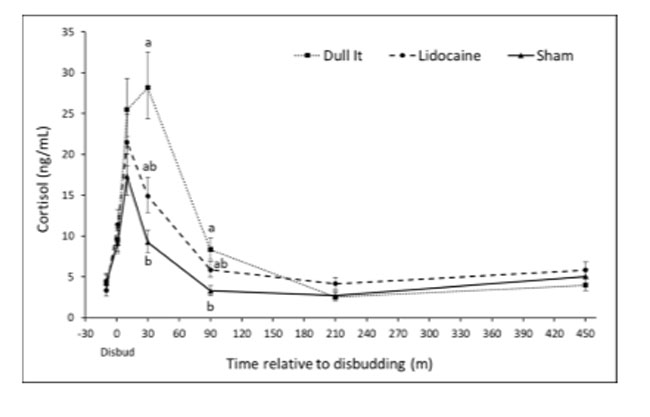By Hannah Phillips, Animal Science graduate student and Brad Heins, Associate Dairy Professor, WCROC
May 2019
Disbudding is a common practice in the dairy industry. This procedure is the preferred method of horn removal — as opposed to dehorning mature cows — which ensures cow and handler safety once heifers reach adulthood. However, this procedure inflicts acute pain and stress in calves and is a welfare concern among consumers. According to a survey in Minnesota, all organic and conventional dairy farms disbudded their heifer calves. This implies that disbudding is a welfare concern for all dairy producers. There are several methods to disbud calves but hot iron cauterization is the most popular process (70% of dairy operations) of horn removal. Although pain and stress during and after hot iron disbudding is well documented, only 28% of producers use analgesics or anesthetics (USDA NAHMS Dairy Study 2014).
The most popular pain management method is lidocaine injected as a cornual nerve block. Although lidocaine reduces pain and stress, it may be an obstacle for some producers. Lidocaine must be injected into the cornual nerve, which is very close to the eye, the injection itself causes pain, and calves feel pain once the numbing effect dissipates. There has been recent consumer and producer interest in natural, noninvasive treatments, leading producers to consider using herbal medicine. However, there is little research on the effectiveness of herbal-based medicine. In the Midwest, Dull It (Dr. Paul's Lab, LLC) is popular herbal treatment used for pain and stress mitigation caused by disbudding. Dull It is a noninvasive herbal tincture which is administered orally to relieve pain and stress in calves caused by disbudding. Dull It is a herbal tincture that contains white willow bark, st johns wort, chamomile, arnica, fennel, alcohol, and apple cider vinegar.
At the University of Minnesota West Central Research and Outreach Center dairy in Morris, MN we wanted to assess the effects of Dull It compared to lidocaine on acute pain and stress of heifer dairy calves from hot iron disbudding by measuring blood serum cortisol and behaviors. We used 54 female Holstein and crossbred calves for the study and seven days prior to the study, calves were acclimated to handling and restraint before disbudding. Calves were randomly assigned to 1 of 3 treatment groups: 1) Dull It (2 mL) under the tongue before disbudding with a second dose immediately following, 2) Lidocaine (5 mL/ bud) cornual nerve block before disbudding, or 3) Sham disbudded with a cold hot iron, to simulate disbudding and stress of handling.
Calves were video recorded for frequencies of ears flicks, head jerks, and tail flicks during disbudding and to six hours after disbudding. The accompanying Figure shows the blood cortisol levels at various times relative to disbudding for the three different groups. At 30 and 90 min after disbudding, the Dull It (28.2 and 8.4 ng/mL, respectively) calves had greater cortisol than sham (9.3 and 3.3 ng/mL, respectively) calves. The Dull It and Lidocaine calves had similar cortisol across all time points after disbudding. The Lidocaine (11.1) calves had greater head jerks 1 to 2 hours after disbudding compared with Dull It (2.8) calves.

Handling alone caused physiological and behavioral responses in calves. Neither Dull It nor lidocaine eliminated pain and stress completely in calves. Dairy farmers may use a higher dose of Dull It and more frequently, or use Dull It and lidocaine together. In summary, Dull It may be an effective alternative to lidocaine to mitigate pain and stress during and after hot iron disbudding in dairy calves.
